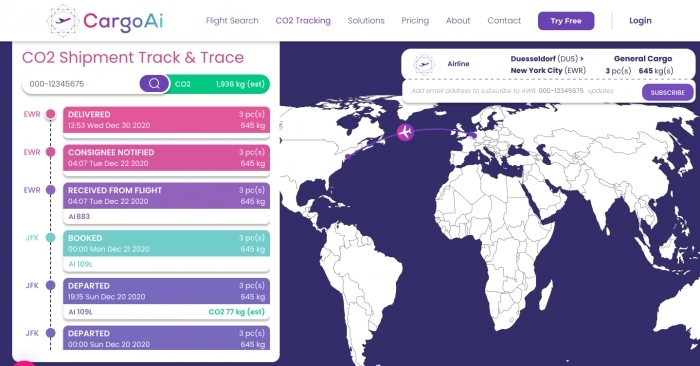CargoAi unveils CO2 emission calculation features for air cargo
March 25, 2021: The SaaS application offering air cargo digital solutions CargoAi launched new features to allow freight forwarder to assess and reduce the CO2 emissions generated by their business activities.

March 25, 2021: The SaaS application offering air cargo digital solutions CargoAi launched new features to allow freight forwarder to assess and reduce the CO2 emissions generated by their business activities.
They can now choose routes and airlines based on their carbon impact and calculate the CO2 emitted from each shipment. Monthly CO2 emissions reports are also available to allow clients to analyse their own impact and monitor improvements.
Anyone can try the CO2 tracking feature for free on www.cargoai.co/co2-track-and-trace
Matthieu Petot, CEO of CargoAi, said, “Cargo stakeholders have really become aware of sustainability, and carbon impact is a recurring topic in discussions with our clients. Through these new features, we wanted to highlight the efforts that airlines are making to reduce their emissions by allowing forwarders to choose their carriers on that basis. It was essential for us to take a position on this issue and to innovate because it’s also another way of thinking about air cargo differently.”
CargoAi’s flight search module gives forwarders access to the CO2 emissions for each airline and route, allowing them to choose their transport solutions accordingly. Also, the free universal track and trace system enables any freight forwarder to track their shipment instead of checking with each airline and calculate at the same time the CO2 emission of the shipment. Finally, the monthly emissions report means forwarders can analyse their carbon impact and monitor improvements.
Several months of development work went into building this complex calculation system, with impartiality the primary goal. As a result, CO2 emissions calculations for all airlines are based on the IATA RP1678 methodology, which is approved by the Global Logistics Emissions Council (GLEC). The European standard DIN EN 16258 can also be used.



